|
ANIMAL
ITEMS:
Alaska Carvings & Travels
Alaska
Artifacts
Animal Carvings-Other
Australian
Art
Bronze Works
Bug & Crab Specimens
Exotic Leather Accessories
Gator Items
Gem Animals
Narwhal Tusks
Parasite
Wood Carvings
Safari Animal
Mounts
Sawfish bills
Shark Items
Shark Jaws
Tagua Nut Carvings
Teak Carvings
JEWELRY
ITEMS
Amber Items
Brooches
Cameos
Czech
brooches
Dichroic Glass
Jewelry
Earrings
Eyeglass Holders
Fairy Stone Crosses
Hatpins
Key chains
Maori Fish Hook Necklaces
Music
Jewelry
Necklaces
Opals &, Ivory Items
Pendants
Rings
Titanium
Jewelry
Vintage
Jewelry
FOSSIL ITEMS
Cave Bear Fossils
Dinosaur
Fossils
Mammoth
Fossils
Fossils-Others
Poop Fossils
Poop-Moose & Deer
Fossil Shark Teeth
CLOSEOUT
SALES:
Marbles
Closeout
Sales-Other
ROCK ITEMS
Meteorites
Rocks & Mineral-Other
OTHER COOL
STUFF FOR SALE
Alien Gifts
Boxes boxes
Gemstone
skulls
Indian
Artifacts
Medallions & Coins
Swords,
Daggers, Knives
The Weirdest
Zoo
books & Books
HUMAN
INTEREST
About Us
Cool
Customers
Jesse Nusbaum, Artist
Latest
Travels
2013 Travel America
Newsletter
Support Our Troops
Tina Memorial
Zany & Fun
FOLLOW us on TWITTER for
special DISCOUNTS



| |
You are on Alaska Page 12
Click to: Alaska Page 1
Page 2 Page 3
Page 4 Page 5
Page 6 Page 7
Page 8 Page
9
Page 10 Page 11
Table of Contents on Page 1
Contents: Virtual Tour of New Bedford Massachusetts
Whaling Museum
| VIRTUAL
TOUR to
NEW BEDFORD WHALING MUSEUM
New Bedford, Massachusetts

In January 1841, a 21-year-old seaman named
Herman Melville set sail aboard a whaling ship on one of the most
important sea voyages in American literature. The book MOBY DICK was
inspired by that voyage, and it was NEW BEDFORD that Melville sailed from
on that voyage. This town was the Whaling Capital of the
World. The whaling industry continued growing another 15
years. The legacy of the whaling history has been retained along
with the historicity of the town itself.
New Bedford was known as the "City that
Lit the World". Whale oil lit city streets and lubricated the
machines of the Industrial Revolution. When petroleum replaced whale
oil, the industry turned its attention to baleen for ladies'
corsets. The story continues below with meeting the Eskimo
people in Barrow Alaska.
|
| BLUE
WHALE SKELETON |



In the main lobby, a spectacular and rare 66
foot long, 4 year old male BLUE WHALE named Kobo - standing for King Of
the Blue Ocean (one of 500 in the North Atlantic struck by a tanker in
1998 near Nova Scotia and pushed on the bow all the way to Rhode Island);
only one of THREE on display in the WORLD. A 33 foot humpback whale
with an unborn calf keeps it company in the lobby. The website link
below gives more fascinating information on the prep of the skeleton.
www.whalingmuseum.org |
| SPERM
WHALE SKELETON |
|

Sperm
whale skeleton, 48 feet long; jaw alone is 12 feet long. It would
have yielded 60 barrels of oil. 


|
| Other
whales and whale parts & oddities |
| Northern
Right Whale mural, called the "right" whale for whalers as it
was a good size and floated when dead. Highly endangered now.


|
Ear
bone of Fin whale

Ear bone of sperm whale

|
Sperm
whale teeth (back row L - below gum line, middle - deformed diseased
tooth, R - bifurcated (divided) tooth; front: Large Sperm whale tooth


|
Vial of krill (Euphosia superba) on L,
Parasitic Isopod (whale barnacle) coronula diadema, common to baleen
whales (middle)


|
| The
Whale in Inupiat (Native Alaskan Eskimo) Culture

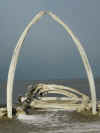
The Eskimo people (Inupiat tribe) in Barrow
Alaska have long hunted whales to use all of it as part of their culture.
(See the famous whale bone arch in Barrow above).
The New Bedford whalers had reason to be
grateful to these people, as they took the whalers in, saved their lives
and gave them shelter & food until spring, after their ship ran
aground on Point Barrow. The
Inupiat Heritage Center in Barrow, Alaska has a world class exhibit
showing their history and culture. You can view a Virtual Tour of
the Heritage Center on Alaska Page 2 |
| Totem
pole, late 19th century, whale rib bone, abalone etc.
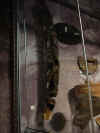
|
Artifact
root pick tool, made of spruce wood and bone

|
Shaman's
amulet, mid 19th century, Pacific NE Native American style of carving of a
whale from a sperm whale tooth

|
Shaman's
ceremonial ladle made of whale baleen & ivory, mid 19th century

|
| Bird
bola (thrown to catch birds), made of walrus ivory, bone, feathers and
hemp; early 20th century
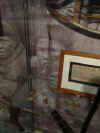
|
More
descriptions of these artifacts


|
The
commercial whalers from New Bedford, Massachusetts hunted further
from home each year due to whale depletion, until Captain Thomas Roys
stumbled upon the bowhead whaling grounds in Bering Strait (Alaska).
The Inupiat people were generous to strangers in need. But as the
whalers depleted the whales and walrus populations, the Inupiat began to
go hungry, and therefore went to work for the whalers on the commercial
ships.
By the 1880's, the whalers began to set up
semi-permanent stations in and near Barrow. The whalers adapted the
Inupiat techniques such as using Inupiat crews to set out from the ice
edge in skin boats (called Umiat), but using their own innovations like
bomb guns to more quickly harvest a whale.

Some commercial whalers decided to stay in the
Arctic and build lives there. Charles Brower and Fred Hopson were
two whalers who married Inupiaq women and founded new dynasties in
Barrow. Their descendents continue the whaling tradition of their
forefathers (both Yankee and Inupiat) to this day. We met numerous
honorable Native people with the last name of Brower in our 3 visits to
Barrow.
|
| LAGODA
WHALING SHIP MODEL

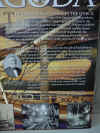
(the largest ship model in the world, 89 feet
long from flying jib boom to the end of the spanker boom), built in 1916 by
New Bedford shipwrights. It symbolizes the zenith of the American
whaling industry. |
| Children
climb all through the ship, what a great teaching tool
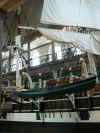

|
You
can appreciate the size of it next to Glenn

|
| SPERM
WHALE JAWS, TEETH & PRODUCTS made from whales, Walrus ivory, and a NARWHAL TUSK
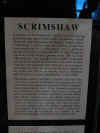
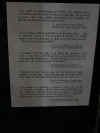
SCRIMSHAW is a whaler's art of engraving and
decorating sperm-whale teeth, and making things from the byproducts of
whaling - baleen, whale bone, walrus tusks and whale bone ribs.
Scrimshandering or scrimshonting was a shipboard pastime during the idle
hours on the whaling grounds in the 19th and early 20th centuries.
They used lampblack or colored inks and dyes to highlight the
etching/engravings. They also made hand tools, yarn winders, sewing
& knitting accessories, kitchen implements such as rolling pins &
pie crimpers, canes & walking sticks, jewelry boxes, chests of
drawers, birdcages or inlaid furniture. |
| Huge
Whale jaw bones in the Lagoda room
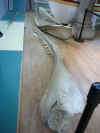
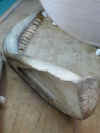
|
Sperm
whale teeth carved with people & flowers. One is Actor John
Kemble in a 1799 production, circa 1830's

|
Sperm
whale tooth - Whale ship William Tell of New York by scrimshaw artist
Edward Burdett of Nantucket, circa 1830; another of a Hawaiian girl

|
| Another
of the same Hawaiian themed sperm whale tooth, and 2 others with Victorian
women

|
3
teeth, 1 carved in high relief flowers, one scrimshaw flowers and the
third a young girl with a teddy bear. Lovely.

|
2
sperm whale teeth, 1 scrimmed with George Washington, the 2nd is a young
girl with a hoop

|
2
sperm whale teeth, 1 looks like Ulysses Grant made into a decorative egg
cup on a base, the 2nd is an American Spread-eagle, circa 1830's

|
| Engraved
etching of sailing ships and whales made from whale jawbone, 19th century.

|
Two sperm whale teeth of whaling ships (though I cannot
read the details on the sign)

|
Five sperm whale teeth showing ships, American flag,
and a tropical scene

|
Steamboats
(though they look like sailing ships), circa 1840's

|
| "Susan's
Tooth" by Frederick Myrick, ship Susan of Nantucket, 1829

|
Pair
of sperm whale teeth, theme of Neptune & Columbia, circa 1850

|
Assortment
of hand made tools made from whale bone - awl, knife, square, etc.

|
An
entire bird cage made of whale bone

|
|
Sperm whale tooth scrimmed of "Ship L C
Richmond"

Pair of sperm whale teeth in high relief carving of
a man and woman

|
Intricate Clocks made with whale bone finials &
inlays
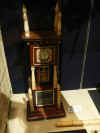
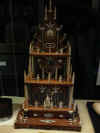
|
Stemware goblet or bud vase carved from sperm whale
tooth; shell flowers. Circa 1850-1875
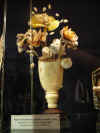
|
A wall sconce made from a sperm whale tooth, with shell
flowers

|
| Waste
paper basket made from sperm whale skeletal bone (ribs), 19th century
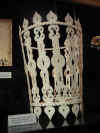 |
An assortment of "busks" and
"flowering" corset-busks elaborately carved, made from whale bone
jaws. It was felt that carving items that would be close to their wife's
body she would wear while he was there or gone was a comforting thought for a
whale man.

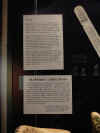
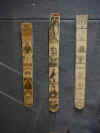
|
Circus
trapeze artist in whale ivory hanging from trapeze
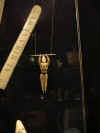
|
|
Two sperm whale teeth, "Burns and Highland
Mary", from a poem by Robert Burns; circa 1840-s to 1850's. Left is a
whaling scene (2nd photo shows back side with more whales), right is a detailed
color scrimshaw of man, woman and tree background


|
A beautiful chest, inlaid with whale bone and ivory

|
An intricate sewing chest of wood with ivory &
whale bone inlays and spindles

|
|
A "Swift" is an intricate yarn-winder.
The cage of the swift opens like an umbrella to hold any size skein of yarn as
it is turned onto it, then allowing it to be pulled off and wound into
balls. If the work is paused, the ball can be stored in the center cup or
a spike finial.


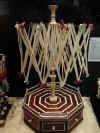
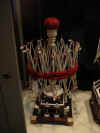
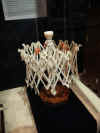
|
| Candle
lantern made of sperm whale pan bone; 19th century

|
Colored
scrimshaw of young men & women on walrus tusks, on a wood display with
ivory knobs and abalone (paua shell) in center
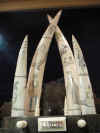
|
Work
basket made of sperm whale skeletal bone, 19th century

Whale ivory "picket fence" style work
basket with wood marquetry platform, 19th century

|
Beautiful
Work sewing basket and knitting needles made of sperm whale pan bone (jaw
bone); mid 19th century

|
| Pair
of sperm whale teeth showing sailing ships with red stars above

|
Deformed (pathologic) sperm whale teeth

|
Engraved
sperm whale pan bone plaque of sailing ships & whales, 19th century

|
Whale
Baleen box etched with lovely designs

|
| Thread
spool holder made of ivory & bone
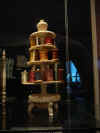
|
Hat box made of solid pieces of whale bone and color
scrimshaw of leaves, ships and whales; lid is tortoise shell inlaid with ivory
scrimshawed with a lovely young woman.

|
Wooden
Jewelry box inlaid with abalone shell

|
Mahogany box with whale ivory inlay, name J. A. Clark
(by Captain Benjamin Clark)

|
|
Various decorative ivory & bone pie crimpers with
incredible scrollwork, seal & deer, horse & hand designs, some with a
fork to puncture the crust. Wonderful art!


Mermaid pie crimper (jagging wheel) of sperm whale
ivory, made by a crew member of the ship Europa, circa 1871-1876; other
decorative pie crimpers beside it

Walrus ivory Pie crimper made by Robert Jones,
afterwards captain of the bark Concordia when she was lost in the Arctic
1871. This crimper is an example of "Neptune's Steed" (hippocanthus)
- the mythical sea monster that pulls "Neptune's Car", a seagoing
chariot. It has a two tined fork and a double fluted jagging wheel with a
pierced work hub that has six spokes shaped like oarlocks.


|
| Scrimshaw
desk, dated 1858. Wooden kneehole writing desk, side drawers fitted
with knob-handles carved from sperm whale ivory made by Capn. James
T. Eldredge aboard the New Bedford bark Congaree. He may have
apprenticed to a carpenter in his youth, judging from the quality of the
piece.
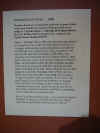
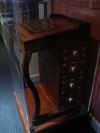
|
Boarding
pistol (Blunt & Syms, Mass, 1840-1850) with a sperm whale tooth handle

|
4
carvings on sperm whale teeth - Detailed village scene and sailing ship,
colored scrimshaw of two beautiful women, the 4th is carved into a vise in
the shape of a fist


|
| WHALING
WIVES
With their
husbands away at sea for extended lengths of time, New Bedford's women
were expected to maintain their families and the community ashore.
They relied on each other, developed an independence that was exceptional
for women of the time. While some were financially independent,
others relied on families or ship owners, others earned money by sewing,
taking in boarders, or operating small shops.

Scrimshaw pair
of sperm whale teeth with theme of whalemen's beloved women back home,
anchor between them (anchor a symbol of hope in the nautical world), circa
1830-1860 |
Pair
of sperm whale teeth scrimmed with a man and woman, a plate with a ship
theme between them; circa 1830-1840

|
| Baleen
ditty box - wood and baleen

|
Ceramics
with native hunting scenes by Inupiaq Eskimo artist Robert Mayokok
(1903-1983), Wales Alaska, circa 1950's. coffee mug & luncheon
plate with walrus hunting vignettes; Dinner plate with whaling vignettes
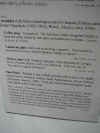

Shot
flask of walrus tusk ivory, relief carved scenes of traditional Native
Alaskan walrus hunt. Note walrus head carved in the wide end.

 |
| Oversize
scrimshaw on a pair of whole sperm whale jaw pans, by Leopold Harnois
(1907-1993). Scenes of sperm whaling in the Bering Strait &
Arctic Ocean, and Right whaling, using prints from Benjamin Russell for
his scenes.
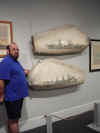




|
Ceramic
pitchers by Buffalo Pottery, 1907, featuring "Sperm Whaling - the
Capture" from the lithograph by Benjamin Russell.

|
| Sperm
whale tooth with scrimshaw of spermacetti whale hunt, illustration from
book by Robert Hamilton, Natural History of the Ordinary Cetacea or
Whales, Vol. 6

|
Sperm
whale tooth, colored pointillist (pinprick) tour-de-force of whaling ship,
flowers and scrollwork above, sperm whale below
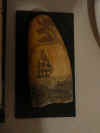
|
Narwhal
tusk
From Pond's Inlet, Baffin Island


|
|
|
AZOREANS and the American Whaling Industry

Azoreans have been mariners & fishers since time
immemorial, involved with the great Portuguese explorations to Africa and the
New World in the 16th century, and European voyages to the Brazil Banks and
Atlantic whaling grounds as early as the 17th century. There were regular
and frequent calls by 19th century American whalers who recruited crews and
provisions there en route to teh whaling grounds. By the 1870's Azorean
veterans of Yankee whale ships settled with their families in New England and
California. Others returned to the Islands and set up shore-based whaling
on their own and a few deep-sea voyages. Ships were modeled after Yankee
prototypes, using methods and tools learned in New England ships, but with a
variety of significant local adaptations. |
| 2
sperm whale teeth, painted as souvenir victory tokens in Fayal,
1944. U.S. military forces were welcomed and stationed there during
WW II. Themes of military ships, friendly people and both flags


|
Museu
dos Balleeiros (Whaling Museum), in Lajes do Pico carved of sperm whale
pan bone, and bronzes of whaling scenes below

|
Sperm
whale tooth scrimshaw of Capt. Nicholas R. Vieira, 2nd tooth carved of a woman
of Fayal wearing a capote hooded cloak (Azorean artist, 20th century)


|
Sperm
whale teeth etched by John Boston of the whale ship Herald, a street scene
of Fayal, a woman wearing the capote hooded cloak, a presentation piece;
the 2nd are scantily clad people, cherubs & angels

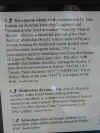
|
| Pair
of sperm whale teeth of woman and man

Pair of sperm whale teeth with strong browed women,
the tip of another showing a Christian cross

|
A
submarine sperm whale tooth, and 2 walrus tusks with fish hooks

|
Oval pierce-work
basket in sperm whale pan bone, 1900, by Manuel Eugenio, an Azorean sailor
coming home on a whaling voyage of 1898-1901 in the New Bedford bark Morning
Star. The sign below describes how he made it.

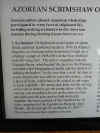
|
| Pair
of sperm whale teeth - Woman with flowing American flag showing American
freedom & nautical prowess; 2nd tooth Rebecca at the Well; by Manuel
Enos (circa 1827)


|
(Circa 1857) Finely engraved pair of sperm whale teeth
showing a military officer with sword and cane, and a goat with wolf

Cane with ivory top


|
| Fist
themed ivory and bone carvings. The fist was a standard motif for
whalemen's scrimshaw of the late 19th and early 20th century.

Another fist carved in ivory

|
Book
of scrimshaw patterns of canes with woman's leg & shoe themes (Captain
William F. Joseph, aboard the bark California), several finished walking
stick pommels, bodkin and figurine of whale ivory & bone with the
finished ideas.

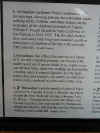
|
An
exceptional scrimshaw of whalers working in their boat

|
| A
beautiful pair sperm whale teeth of women, one with a fan

|
Color
scrimshaw of a women, on a pair of sperm whale teeth

|
"Home
Sweet Home" in pointillist work

|
|
| Sperm
whale tooth scrimshaw of an exotic woman with long hair and large flower

Pair
of sperm whale teeth, likely a husband and wife

|
Sperm
whale tooth scrimshawed as a sweet faced woman, cluster of grapes on the
reverse

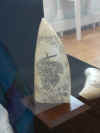 |
3
carved sperm whale teeth; 1 carved in high relief of African people in
boats and carrying goods; middle carving is of a soldier, right is a dancing African
couple (Loango coast of SW Africa, 19th century). African people
acquired these in trade from the whaling ships

 |
| Shark
vertebrae walking cane often made on shipboard.
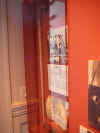
|
Harvesting
a whale jaw from a sperm whale aboard the brig Daisy, 1913
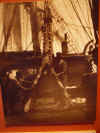
|
Understanding
the time on a whaling ship
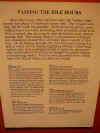
|
The Dutch & Flemish took interest in all animal
specimens.
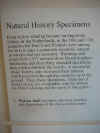
|

Sperm whale teeth, 1 whole (L), split (2nd
from L); whale ear bone (lower R)

|
Walrus head mount & tusks
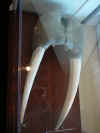
|
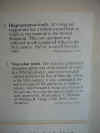
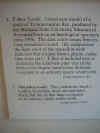
 Mammoth
tooth above, (mislabeled mastodon tooth), hippo tooth below; T-Rex tooth
upper R, Megalodon tooth, lower R (mislabeled Monodon tooth); we did
notify a docent at the museum of the errors. |
|
BRITISH SCRIMSHAW EXAMPLES


A large display case showing scrimshawed plaques of
sperm whale pan bone, rib bones, baleen and teeth, walrus ivory pie crimper, and
ivory bead necklace, ivory inlaid wooden box, corset busks, also a scrimshawed
ostrich egg.
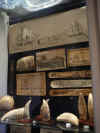


A tooth in the left-hand photo shows a British flag;
3rd photo is a closer photo of the ostrich egg scrimshawed with a whaling ship
(whalers would acquire these as souvenirs from African ports-of-call); Far right
photo is a lightly etched sperm whale tooth showing St. Paul's Cathedral.




A raised relief ancient Pictish woman semi-nude in
full battle regalia with tattoos, an exquisite braided pattern on the rope mat
beneath her feet. 2nd photo is a close-up of the ivory bead necklace,
inlaid ivory in the wood box, etc.
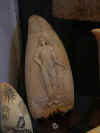


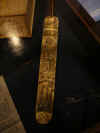
Boxes cut from whale pan (skull) bone, what a
versatile material.

|
|
The earliest known dated pictorial sperm whale tooth
scrimshaw inscribed: "This is the tooth of a sperm whale caught near
the Galapagos Islands by the crew of the ship Adam and made 100 barrels of oil
in the year 1817".


|
| GIFT
SHOP |
| Exquisitely
detailed frames of shell flowers. We saw vintage examples within the
museum too though we did not photograph them, it finally struck me how
unusual these were by the time we came full circle to the gift shop.


|
Click to: Alaska Page 1
Page 2 Page 3
Page 4 Page 5
Page 6 Page 7
Page 8 Page
9
Page 10 Page 11 |